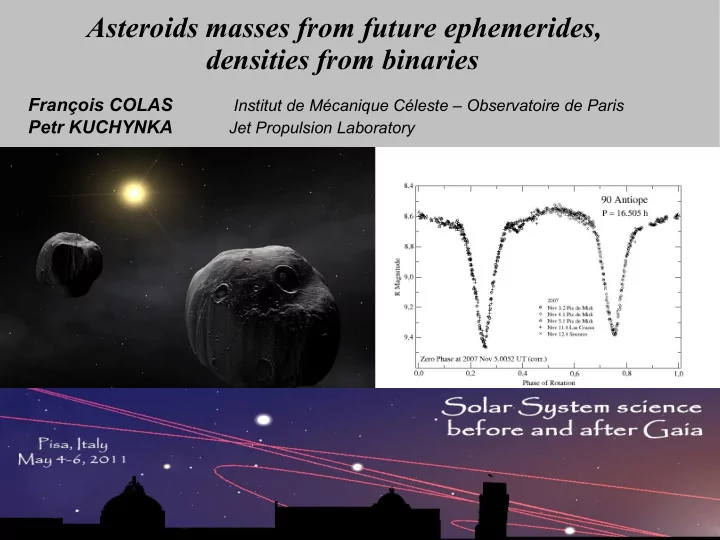

Asteroids masses from future ephemerides, densities from binaries François COLAS Institut de Mécanique Céleste – Observatoire de Paris Petr KUCHYNKA Jet Propulsion Laboratory
Densities measurements Most of the asteroids have not evolved since solar system formation - Asteroids densities are keys for : - Solar system formation - Evolution - Impacts and evolution of the solar system - Densities + Spectroscopic observations => macro porosity - fracturation - rubble piles - collisional history - ...
Actual situation Accuracies of actual best masses (blue dots) and best densities (red dots)
About 200 asteroid masses will be known in the next 10 years using different ways, Mars orbit perturbations, Mutual perturbations, Flyby, Binary asteroids GAIA will permit to determine several masses
Mars perturbations As we know Mars orbit with a meter accuracy and as asteroids can perturb Mars orbit of more than one kilometer, it is possible to measure some asteroids masses (INPOP-10a A.Fienga et al 2011) - we supposed that Mars orbit will be still known with an one meter accuracy until 2020, we found 167 objects with masses that can be measured with an accuracy better than 50% 40% => 115 30% => 50 60 - 50 40 30 Er % 20 10 0 0 20 40 60 80 100 120 140 160 180 Asteroid Mass determination
Binaries Occultations Light curves
Single 39 Laetitia light curve Single 39 Laetitia light curve
Binary asteroid light curves
Expérience pédagogique niveau terminale PHOTOMETRIE : Eléments physiques ( λ p, β p) – travaux pratiques Réalisation du Lycée de l'Arc
Direct density estimation
Prédictions... N S N
Four binaries founded on 400 light curves No bias on statistic We can do the same with Gaia by searching light curves with anomamies
(7225) Huntress An exemple of low amplitude transit / occultation P orb = 14.67 ± 0.01 h P.Pravec D 2 /D 1 = 0.21 ± 0.02 P 1 = 2.4400 ± 0.0001 h A 1 = 0.11 mag
We know 162 multiple astéroids (5 triples, 1 quadruple) (may 2010) 35 NEOs, 7 Mars-Crossers, 62 MBO, 2 Trojans, 56 TNOs • Discoveries , – HST (47) -- – Ground based (29) – 8 m class telescopes (8-10m) with AO – Ground based, light curves (62) – Small telescopes (1m-30cm), – Radar (21) – Mainly Arecibo - NEO – Space missions (1) .... .
Low resolution spectrography : minéralogy Infrared photometry from ground based observations => Thermal inertia (eclipse observations) 2005 type S (pôle N) 1996 type S (pôle N) 1997 type C (pôle S)
Occultations
T 193 – Sutherland RSA – Pluto Occultation – june 2008
Small size observatory !
Video Observatory
New observational strategy : - good spatial resolution - many small observatories - bright occulted star - go anywhere on Earth...
Résult :-(((( We need a good astrometry !! (1 mas at 2UA = 1.5km)
Timing problems (472) Roma – 2011 July 8th
Accuracy ? Occultation of HIP 19388 by (345) Tercidina 17 september 2002 Apparent motion on the sky : 25.92"/h => 7.2 mas/s Timing accuracy: 0.04s For tercidina 0.29 mas => 350 m
Occultations of binary Asteroids (532) Herculina 1978 (216) Kleopatra 1980 (146) Lucina 1982 ( 71) Niobe 2005 ( 22) Kalliope 2006 ( 90) Antiope 2008 (216) Kleopatra 2009 (234) Barbara 2010 Et bien sur : (134340) Pluto - Charon
Kalioppe
Observations
Antiope occultation – 2011 july 19th
Recommend
More recommend